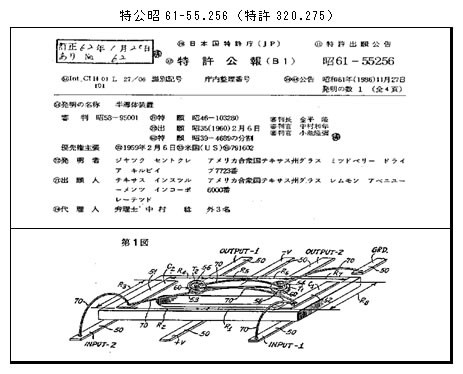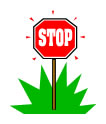Enforcement Of Obviously “Invalid” Patent Kilby-Patent Case
About Kilby Patent
The widely-known “Kilby patent” has been derived from the individual name, Mr. Kilby. The patent publication shown below is that of the disputed patent, on which the name of the inventor, “Jack St. Clair Kilby,” is explicitly written along with the address. The volume of the printed patent, 4 pages in total, appears to be unexpectedly small in contrast to its large impact on the subsequent Japanese practices.

Background Of Patent Right
The disputed patent had problems.
1) Same in invention as original application
The disputed patent was a divisional one with respect to an application (original application). The problem was that the disputed invention appeared to be “substantially identical” to the invention claimed in the original application.
2) Rejected original application
The original application as a parent of the divisional had been rejected because the original invention had been determined as “an invention that could have easily been made on the basis of well-known art” (lack of inventive step). The disputed invention “substantially identical” to such an original invention should have been rejected. However, a delay in finding such substantial identity was caused by expressional differences between the divisional and parent in the examination/appeal stages, and patent of the above patent publication had been granted with respect to the divisional.
Judgment Of High Court
The Tokyo-High Court’s judgment affirmed by the Supreme Court, which dismissed a petition of final appeal, was as follows:
1) To be rejected as later application
The divisional is deemed to be filed at the time of filing of the original application if it complies with the relevant act. The disputed application of the claimed invention identical to the original invention, however, did not comply with the relevant act, and therefore, was treated as merely a later application filed after the original application had been filed. Thus, the disputed patent had an extremely high probability of being invalidated under Patent Act, Article 39(1) (a later application identical in claimed invention to an earlier application shall be rejected).

2) To be rejected for easily-made invention
The final rejection had been provided for the original invention as “an invention that could have easily been made on the basis of well-known art.” In this respect as well, it may safely be said that the disputed patent of the claimed invention substantially identical to the original invention was potentially invalid.
3) Abuse of right
The enforcement to a third party based upon the disputed patent right having an extremely high probability of being invalidated should not be allowed because it falls under the abuse of right.
Grounds For Petition Of Final Appeal
With complaints about the above judgment by the Tokyo High Court, the patentee filed a petition of final appeal on the grounds that the determination in above 1), 2) did not comply with the relevant act, and the abuse of right in above 3) in particular had erroneously been applied in the following manner:
In a patent infringement lawsuit, whether or not the alleged infringing object falls within the technical scope of the patent claim should be determined on the assumption that the patent right would be valid; nevertheless, the original judgment determining that the disputed patent right was substantially invalid was unlawful for a breach of law, inexhaustive examination, and absence of reasons.

Opinion Of Supreme Court
For the above grounds for the petition of final appeal, the Supreme Court held that:
1) Rejection as later application
Firstly, as a result of analysis of earlier/later relations between the original and disputed applications, since the original application was qualified as an earlier application in spite of the issuance of the final rejection, the disputed application should have been rejected as a later application under Patent Act, Article 39(1).
2) Grounds for invalidation
The final rejection had been provided for the original application on the grounds that the original invention could have easily been made on the basis of well-known art. Since the disputed invention was substantially identical to the original invention, it is obvious that the disputed patent granted against Patent Act, Article 29(2) for the same grounds was invalid under Patent Act, Article 123(1)(2). Since there were no specific circumstances where request for correction appeal had been filed or the like, the invalidity of the disputed patent was certainly foreseen.
Regarding Abuse Of Right
Secondary, the abuse of right as a principally disputed issue was analyzed.
1) Significance of invalidation appeal
For the invalidation appeal, it was determined that the allegedly invalid patent is invalidated exclusively by the JPO’s Board of Appeal having expert knowledge and experience, and the final and binding decision of invalidation causes the patent right to be deemed non-existent from the beginning. It was determined, therefore, that the patent right should survive as lawfully valid, and should not be invalidated against third parties until the final and binding decision of invalidation is provided.
2) Obvious grounds for invalidation
If the patent obviously involves the grounds for invalidation like the disputed patent, and request for invalidation appeal is filed, there is a circumstance where the invalidity of the patent is certainly foreseen. In view of the points shown below, it was determined as inappropriate that claiming injunction and damages on the basis of the patent right would be construed as being acceptable even in such a circumstance.
- To allow claiming injunction and damages on the basis of such a patent right would substantially provide a patentee with inappropriate advantages while provide an opposite party implementing the patented invention with inappropriate disadvantages, which is against the doctrine of equivalents.
- It is preferable that a dispute is resolved in a minimal period of time in accordance with one set of proceedings. In this respect, if raising the invalidity as a defense against an infringement lawsuit based upon the above patent right is not allowed unless the decision of invalidation is provided in a final and binding manner through the JPO’s invalidation appeal, the opposite party, who does not intend to raise the invalidity of the patent against third parties, is supposed to proceed with the invalidation appeal proceedings, which is contrary to the economical litigation.

- Patent Act, Article 168(2) (stipulating a system where, upon request for invalidation appeal, the court may suspend the court proceedings without their own judgment as long as the appeal proceedings continue, if they consider it as necessary) should not be construed as stipulating the suspension of the court proceedings even under a circumstance where the patent obviously involves the grounds for invalidation, and its invalidity as described above is certainly foreseen.
3) Conclusion
As a consequence, even before the final and binding decision of invalidation of the patent is provided, it should be construed that the court, which examines a patent infringement lawsuit, can determine whether the patent obviously involves the grounds for invalidation or not. If the examination result is that the grounds for invalidation are obviously involved by the patent, it is appropriate to construe that claiming injunction and damages based upon such a patent right is not allowed as an abuse of right unless there is a specific circumstance. Such a construction is not contrary to the purports of the patent system.
Among precedent cases, the case different from the above opinion should be changed to such an extent that only a portion conflicting with the above is changed.
4) This case
As a result of the above analysis, it was found that the disputed patent obviously involved the grounds for invalidation, and that there were no specific circumstances where the correction appeal had been requested or the like. The Tokyo-High Court’s judgment, that the claim of damages based upon the disputed patent right was not allowed as an abuse of right, was therefore affirmed.
Impact Of This Judgment
According to the judgment, Patent Act was reformed to newly include Article 104-3(1) stipulating that, in a patent infringement lawsuit, a patentee (or an exclusive licensee) shall not enforce a patent right to an opposite party, if it is considered that the patent would be invalidated in the invalidation appeal. In spite of the existence of the patent right, the enforcement of such a right is prevented. The obviousness had been required by the judgment in the manner of “・・・if the patent ‘obviously’ involves the grounds for invalidation・・・”; however, the reformed Patent Act did not provide such “obviousness” requirements. In comparison with the rule provided by the precedent case, the accused infringer would be provided with further advantages under the rule provided by the reformed Patent Act.
If you have any questions concerning the above, please feel free to contact us by sending email to inter@ypat.gr.jp.
